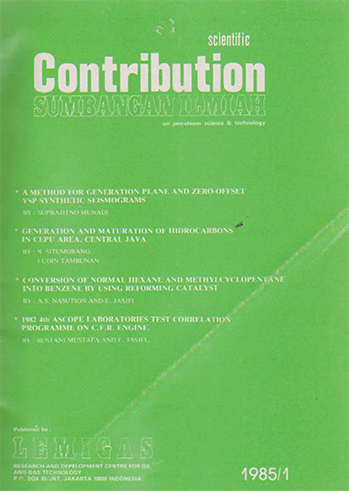CONVERSION OF NORMAL HEXANE AND METHYLCYCLOPENTANE INTO BENZENE BY USING REFORMING CATALYST
DOI:
https://doi.org/10.29017/SCOG.8.1.1164Keywords:
Hexane, Methylcyclopentane, BenzeneAbstract
As the significant amount of paraffins and naphthenes in the reforming feedstock, the conversion of these hydrocarbons to aromatic in the catalytic reforming process thus plays an important role. An experiment has been carried out to study the reaction rate of normal hexane and methylcyclopentane into benzene by using reforming catalyst
References
Wuithier, P. Refftnage et Genie Chimlque. Edition Technip, Paris, 1s France, 1965.
Sachanen, AN, The Chemistry of petroleum kydro- carbon, vol 1, S Rheinhold Publ.Corp. NY. USA, 1954.
Germain, J.E et all, J. Chim. Pys, 60, 1219, 19963
Nasution, AS., Presented Puper on the 3rd Pacifle Chemical Engineering, Seoul, Korea, May 8- I1. 1983.
Hettinger, WP. and Keith, CD. Int. Eng Chem. 47 (41L 719. 1955.
Clapetta, FG. et all, Catalysta reviewe, Chapter 5,67.
Germain, JE, Catalytic Conversion of Hydrocarbons, Academic Press, London, 1969.
Heina Heinemana and Miles, GA. Ind. Eng. Chem, 43 (1L 140, 1953.
Downloads
Issue
Section
License
Copyright (c) 1970 SCIENTIFIC CONTRIBUTIONS OIL AND GAS (SCOG)

This work is licensed under a Creative Commons Attribution 4.0 International License.
Authors are free to Share — copy and redistribute the material in any medium or format for any purpose, even commercially Adapt — remix, transform, and build upon the material for any purpose, even commercially.
The licensor cannot revoke these freedoms as long as you follow the license terms, under the following terms Attribution — You must give appropriate credit , provide a link to the license, and indicate if changes were made . You may do so in any reasonable manner, but not in any way that suggests the licensor endorses you or your use.
No additional restrictions — You may not apply legal terms or technological measures that legally restrict others from doing anything the license permits.














